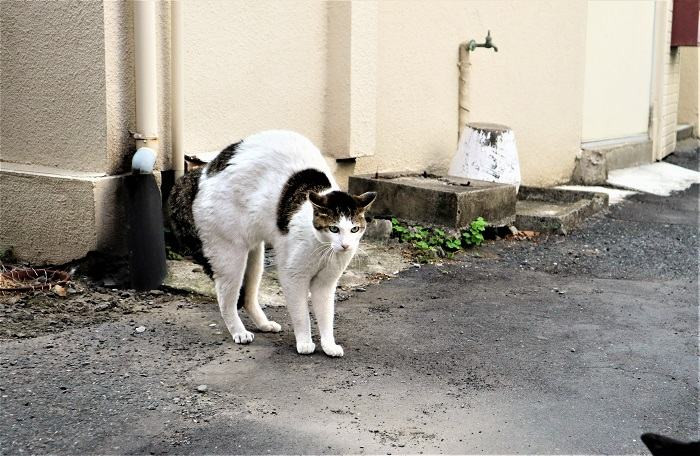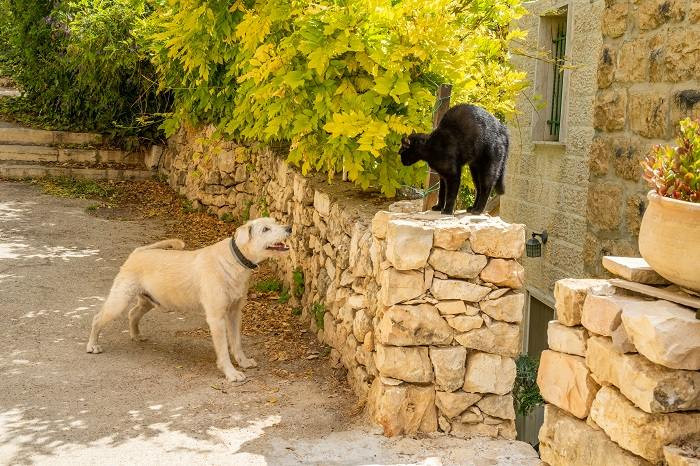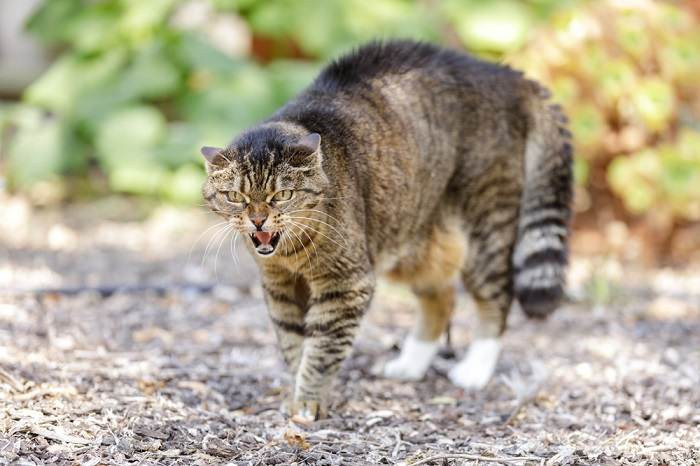Cats are renowned for their agility and flexibility, a trait largely attributed to their unique spinal structure. Unlike many other animals, cats possess an extraordinary range of motion in their spines, allowing them to rotate and twist in ways that often seem almost liquid. You’ve likely witnessed your feline companion arching its back during a good scratch or a leisurely stretch. But did you know that this seemingly simple posture can be a window into your cat’s emotional and physical state? A Cat Arched Back can signify a spectrum of feelings, from contentment and playfulness to fear, aggression, or even pain.
In this comprehensive guide, we’ll delve into the various reasons behind why cats arch their backs, unraveling the meaning behind this often enigmatic body language. Understanding these nuances can deepen your bond with your cat and help you better interpret their needs and emotions.
8 Key Reasons Behind a Cat Arched Back
A cat’s arched back is a multifaceted signal, influenced by a blend of behavioral and physiological factors. Let’s explore eight common reasons why your cat might adopt this distinctive posture:
1. The Invigorating Stretch
Just like humans, cats need to stretch to maintain their physical well-being. Their elegant, elongated spines are designed for flexibility, requiring regular extension to keep muscles and tendons supple and in optimal condition. Stretching is a natural and routine behavior for cats, often observed when they first awaken from a nap or after periods of rest. You might even notice a simultaneous yawn accompanying their stretch, further emphasizing their awakening or relaxation.
Cats exhibit two primary stretching styles. One involves standing and extending their forelimbs forward, drawing their body towards their rear legs in a forward-bending stretch. The other, more pronounced stretch, involves extending all four limbs while upright and simultaneously arching their back. In this full-body stretch, they may appear to be standing on their tiptoes as their legs fully extend, maximizing the spinal arch.
Stretching offers numerous benefits for cats, mirroring those for humans. It enhances flexibility, boosts circulation and blood flow, aids in flushing out bodily toxins, and effectively prepares their muscles for bursts of activity, like pouncing, after periods of inactivity.
2. Sensing Danger: The Halloween Pose
 Fearful cat in Halloween pose with arched back
Fearful cat in Halloween pose with arched back
The “Halloween cat” pose, characterized by a dramatically arched back, is an unmistakable indicator of fear in cats.
Despite their domesticated nature, domestic cats retain strong instincts for self-preservation. They are naturally alert creatures, possessing a heightened sense of their surroundings. Cats are adept at detecting potential threats, and can quickly transition into a state of anxiety when startled, restrained, displaced from their familiar home environment, or when they perceive any form of danger.
The quintessential “Halloween cat” pose serves as a classic illustration of feline fear. This posture is characterized by a tilted stance, with the rear end highly arched while the feet remain drawn closely together. Piloerection, commonly known as raised hackles, is evident as their fur stands on end, making them appear larger. Their eyes may exhibit a fixed stare with dilated pupils, and their mouth might be slightly open, possibly accompanied by hissing or growling.
Read More: Why Is My Cat Staring At Me? Top 5 Reasons Explained
When a cat displays these fear signals, it’s crucial to avoid approaching or attempting to touch them. Doing so can escalate their anxiety and potentially lead to defensive behaviors like scratching or biting. Providing a safe and quiet space for them to retreat and calm down is the most supportive approach in these situations.
3. Happiness and Excitement: A Sign of Affection
One of the most heartwarming reasons for a cat arched back is pure joy and excitement. Many cat owners witness this delightful behavior during feeding times or when engaging in play. For instance, your cat might greet you at mealtime with its tail held high and quivering like a rattlesnake, its back arched in anticipation as it rubs against your legs.
Distinguishing between a happy arched back and a fearful one is usually straightforward. When a cat arches its back out of happiness or pleasure, its overall demeanor will be relaxed and inviting. They may purr contentedly, rub against you affectionately, initiate head-butts as a sign of bonding, and follow you around or settle down comfortably beside you. These accompanying behaviors provide clear context to their arched back, indicating positive emotions.
4. Warning Signal to Other Animals: Maintaining Territory
 Cat arching back to warn off other animals
Cat arching back to warn off other animals
Cats might arch their backs and raise their fur to appear larger and more intimidating when warning off potential threats.
Cats are territorial creatures, and an arched back can serve as a distance-increasing signal when they perceive neighboring cats or dogs encroaching on their space. This posture essentially communicates, “Do not come any closer.” This behavior typically arises when a cat feels that its personal safety, territory, or valuable resources like food and water are potentially threatened.
When a cat feels threatened and aims to deter an intruder, it will often attempt to maximize its perceived size. This involves piloerection along their spine and tail, standing tall on straight legs, often on their tiptoes, and prominently arching their back. The cat might also turn its body sideways to further amplify its size and rotate its ears either forward to focus on the threat or backward in a defensive posture. Observing this behavior can be a key indicator of territorial disputes or the presence of other animals nearby.
5. Playful Invitation: Engaging in Fun
Play behavior is particularly prevalent in kittens and younger cats, but adult cats also retain their playful instincts. A cat arched back can be a key component of their playful interactions. You can readily recognize a playful arched back by observing accompanying behaviors:
- Side-step: A cat initiating play might move sideways towards another cat (or even a human playmate), with its body arched and its tail held in an upward curl. They might circle their potential playmate, approaching from the side in a playful manner.
- Horizontal leap (Crab Walk): Often referred to as the “crab walk,” this playful behavior is commonly observed in kittens. The cat will adopt the side-step posture described above but will suddenly leap sideways with an arched back. Play can be directed socially towards another animal, or object-directed towards a favorite toy, sibling, a dog, or their human caregiver.
6. Urine Marking: Scent Communication
Marking behavior is a crucial aspect of feline communication, relying heavily on scent signals. Urine marking, or spraying, involves a distinct posture: a standing position with a vertically held, quivering tail, a slightly arched back, and the release of a small amount of urine.
Unaltered (non-neutered) male and female cats commonly urine mark to advertise their sexual availability and reproductive status. However, if a spayed or neutered cat begins urine spraying indoors, it can indicate underlying issues. This behavior might be a way of communicating discomfort due to an illness, anxiety, a perceived threat within their environment, stress, or territorial insecurity.
Urine marking is an instinctive feline behavior. If it becomes problematic or distressing, seeking guidance from your veterinarian or a certified animal behaviorist is recommended to identify the cause and implement appropriate solutions.
7. Displaying Aggression: A Hostile Posture
 Aggressive cat with arched back and raised fur
Aggressive cat with arched back and raised fur
Similar to a fearful cat, an aggressive cat may arch its back with raised fur, often accompanied by hissing, growling, or spitting.
An arched back can also be a component of aggressive feline behavior. Hostile postures are characterized by facing an opponent directly or moving towards them in a confrontational manner. Piloerection is often present, making the cat appear larger and more intimidating. Other signs of aggression include dilated pupils, ears and whiskers pointed forward to focus on the threat, a direct stare, and vocalizations like hissing, growling, or howling at the perceived enemy. Aggression can arise from frustration, anger towards familiar or unfamiliar individuals, illness-related irritability, or territorial disputes with other cats.
While aggression is a natural part of feline behavior, cats generally prefer to avoid physical confrontations. If your cat exhibits aggressive behavior towards you, other people, or other pets in the household, it warrants prompt attention. A medical evaluation and behavioral intervention may be necessary to address the underlying causes and ensure the safety and well-being of everyone involved.
8. Pain or Discomfort: Medical Considerations
Lastly, it’s important to consider that a cat arched back can sometimes be a sign of physical discomfort or pain. Cats, like humans, experience pain and illness, and changes in their behavior, posture, or movement can be indicators of an underlying medical condition.
Be alert to accompanying behavioral changes such as reluctance to be handled, increased aggression (often due to pain), lethargy, loss of appetite (inappetence), excessive grooming, and increased vocalization.
Localized pain in the chest or abdomen can cause a cat to adopt a hunched or crouched posture. When experiencing back or abdominal pain, a cat might stand or lie on its side with an arched back, or walk with a stiff, unnatural gait. Furthermore, a cat that shows hesitation when navigating stairs, walks with an arched back, struggles to get out of bed, or exhibits stiff joints or lameness might be suffering from osteoarthritis or other musculoskeletal issues.
Trust your instincts and carefully observe your cat’s overall demeanor and any accompanying symptoms. If you notice a combination of these signs, it’s crucial to consult with your veterinarian without delay to rule out any underlying medical conditions and ensure your cat receives appropriate care.
Final Thoughts
Cats possess remarkably flexible and complex bodies, and arching their backs is a common and multifaceted behavior. It serves as a valuable communication tool, reflecting a wide range of emotions and physical states, from contentment and playfulness to fear, aggression, or even pain. Paying close attention to subtle changes in your cat’s behavior and overall body language is key to accurately interpreting their mood and intentions before interacting with them. Understanding the nuances of a cat arched back enhances your ability to respond appropriately to your feline companion’s needs and strengthens the bond you share.
Frequently Asked Questions
Why do cats arch their back when you pet them?
Generally, when a cat arches its back while you pet them, it’s a positive sign of affection and enjoyment of being touched. A happy cat in this state might also purr loudly, meow contentedly, and even head-butt you simultaneously, further reinforcing their positive response to your interaction.
Why does my cat arch its back when it sees me?
If your cat arches its back upon seeing you, it’s typically a friendly and happy greeting. It’s often an invitation for interaction, which could include playtime, a request for food, a desire to be petted, or simply seeking your attention. This arched back greeting is a positive sign of your cat’s bond with you.
Why do cats arch their backs when being stroked?
When a cat arches its back while being stroked, it could be presenting its hindquarters as a sign of affection and trust, indicating they want you to focus on petting their preferred spot on their body, often near the base of their tail. A cat might also circle around you while arching its back to express contentment and solicit continued interaction.
However, context is crucial. An unspayed female cat in heat will sometimes exhibit similar behaviors – raising her hindquarters, rolling around, meowing persistently, and pacing – when stroked, as these actions are related to her estrous cycle.
Conversely, it’s also possible for a cat to arch its back in response to touch aversion or discomfort. In these cases, the arched back might be accompanied by other negative signals like tail thrashing, hissing, or swatting, indicating they want you to stop petting them. It’s best to respect these signals and give the cat space until you’ve built more trust and they are more comfortable with touch, to avoid causing distress or overstimulation.
View Sources
Cats.com prioritizes the use of high-quality and credible sources, including peer-reviewed studies, to substantiate the information presented in our articles. Our content undergoes regular review and updates to ensure accuracy and reliability. For more information about our editorial standards and veterinary review board, please visit our About Us page.
- Care, I. C. (2020, September 01). Advanced Feline Behaviour for Vet Professionals Module 2 Senses and communication. UK. Retrieved May 10, 2022
- Care, I. C. (2020, September 01). Module 8 Clinical Animal Behaviour Part 1. International Cat Care Advanced Feline Behaviour for Vet Professionals. UK. Retrieved May 20, 2022
- Fraser, A. F. (2012). Feline Behaviour and Welfare. (S. Hulbert, Ed.) CAB International. Retrieved May 21, 2022
- Heath, I. R. (2016). Feline Behavioral Health and Welfare. St Louis, MO: Elsevier. Retrieved May 24, 2022
- ICatCare, U. a. (2010). Cat Behaviour Described Chapter 1 Maintenance Behaviour. (U. o. Lincoln, Compiler) UK. Retrieved May 23, 2020

